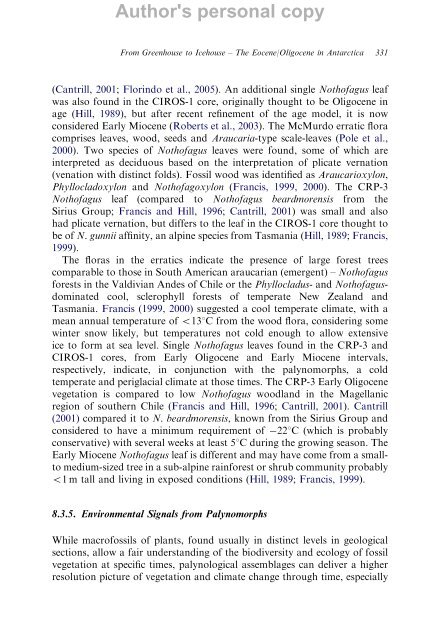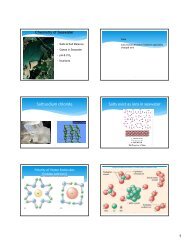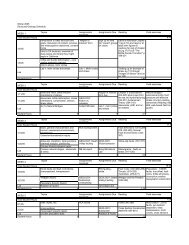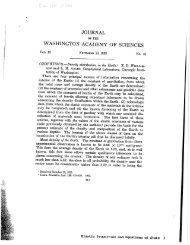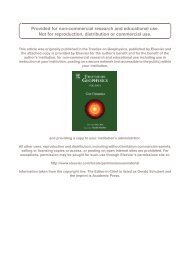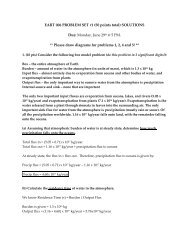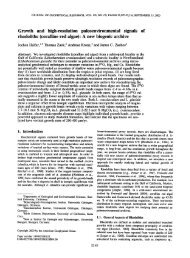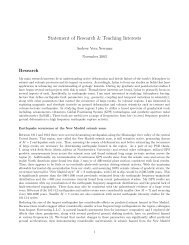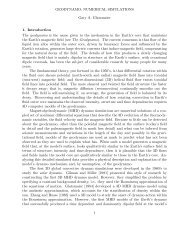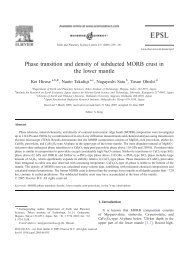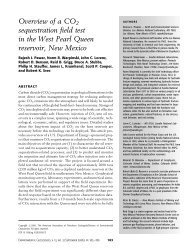From Greenhouse to Icehouse – The Eocene/Oligocene - UMass ...
From Greenhouse to Icehouse – The Eocene/Oligocene - UMass ...
From Greenhouse to Icehouse – The Eocene/Oligocene - UMass ...
Create successful ePaper yourself
Turn your PDF publications into a flip-book with our unique Google optimized e-Paper software.
Author's personal copy<br />
<strong>From</strong> <strong>Greenhouse</strong> <strong>to</strong> <strong>Icehouse</strong> <strong>–</strong> <strong>The</strong> <strong>Eocene</strong>/<strong>Oligocene</strong> in Antarctica 331<br />
(Cantrill, 2001; Florindo et al., 2005). An additional single Nothofagus leaf<br />
was also found in the CIROS-1 core, originally thought <strong>to</strong> be <strong>Oligocene</strong> in<br />
age (Hill, 1989), but after recent refinement of the age model, it is now<br />
considered Early Miocene (Roberts et al., 2003). <strong>The</strong> McMurdo erratic flora<br />
comprises leaves, wood, seeds and Araucaria-type scale-leaves (Pole et al.,<br />
2000). Two species of Nothofagus leaves were found, some of which are<br />
interpreted as deciduous based on the interpretation of plicate vernation<br />
(venation with distinct folds). Fossil wood was identified as Araucarioxylon,<br />
Phyllocladoxylon and Nothofagoxylon (Francis, 1999, 2000). <strong>The</strong> CRP-3<br />
Nothofagus leaf (compared <strong>to</strong> Nothofagus beardmorensis from the<br />
Sirius Group; Francis and Hill, 1996; Cantrill, 2001) was small and also<br />
had plicate vernation, but differs <strong>to</strong> the leaf in the CIROS-1 core thought <strong>to</strong><br />
be of N. gunnii affinity, an alpine species from Tasmania (Hill, 1989; Francis,<br />
1999).<br />
<strong>The</strong> floras in the erratics indicate the presence of large forest trees<br />
comparable <strong>to</strong> those in South American araucarian (emergent) <strong>–</strong> Nothofagus<br />
forests in the Valdivian Andes of Chile or the Phyllocladus- and Nothofagusdominated<br />
cool, sclerophyll forests of temperate New Zealand and<br />
Tasmania. Francis (1999, 2000) suggested a cool temperate climate, with a<br />
mean annual temperature of o131C from the wood flora, considering some<br />
winter snow likely, but temperatures not cold enough <strong>to</strong> allow extensive<br />
ice <strong>to</strong> form at sea level. Single Nothofagus leaves found in the CRP-3 and<br />
CIROS-1 cores, from Early <strong>Oligocene</strong> and Early Miocene intervals,<br />
respectively, indicate, in conjunction with the palynomorphs, a cold<br />
temperate and periglacial climate at those times. <strong>The</strong> CRP-3 Early <strong>Oligocene</strong><br />
vegetation is compared <strong>to</strong> low Nothofagus woodland in the Magellanic<br />
region of southern Chile (Francis and Hill, 1996; Cantrill, 2001). Cantrill<br />
(2001) compared it <strong>to</strong> N. beardmorensis, known from the Sirius Group and<br />
considered <strong>to</strong> have a minimum requirement of 221C (which is probably<br />
conservative) with several weeks at least 51C during the growing season. <strong>The</strong><br />
Early Miocene Nothofagus leaf is different and may have come from a small<strong>to</strong><br />
medium-sized tree in a sub-alpine rainforest or shrub community probably<br />
o1 m tall and living in exposed conditions (Hill, 1989; Francis, 1999).<br />
8.3.5. Environmental Signals from Palynomorphs<br />
While macrofossils of plants, found usually in distinct levels in geological<br />
sections, allow a fair understanding of the biodiversity and ecology of fossil<br />
vegetation at specific times, palynological assemblages can deliver a higher<br />
resolution picture of vegetation and climate change through time, especially


